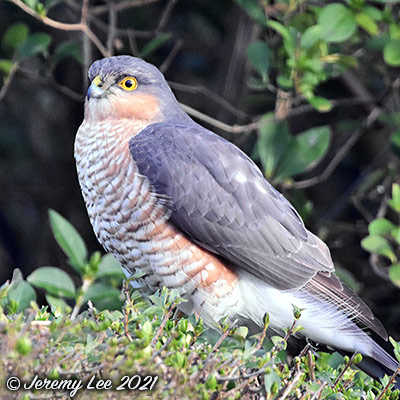
 |
|
Scientific Classifications explained » Amphibians » Ants » Aphids » Bees » Beetles » Birds » Bugs » Butterflies » Caterpillars » Damselflies » Dragonflies » Earwigs » Flies » Frog/Leafhoppers » Fungi » Galls » Grasshoppers » Harvestmen » Hoverflies » Lacewings » Ladybirds » Leaf Mines » Lichens » Mammals » Millipedes » Mosses » Moths » Sawflies » Slugs » Snails » Spiders » Trees & Shrubs » Wasps » Wild Flowers » Woodlice » Postboxes |
UK Nature > Birds > Accipiter nisus

Scientific Name: Accipiter nisus Common Name: Sparrowhawk Accipiter nisus, more commonly known as the Sparrowhawk, is a small bird of prey. They're adapted for hunting birds in confined spaces like dense woodland, so gardens are ideal hunting grounds for them. Adult male sparrowhawks (see above photo) have bluish-grey back and wings and orangey-brown bars on their chest and belly. Females and young birds have brown back and wings, and brown bars underneath. Sparrowhawks have bright yellow or orange eyes, long, yellow legs and long talons. Females are larger than males, as with most birds of prey. Sparrowhawks breed in woodland but also visit gardens and more open country. They can be seen in towns and cities, as well as rural areas. Listen for the alarm calls of smaller birds as they spot a sparrowhawk and will alert other birds in the area to the danger. In the UK sparrowhawks are found everywhere, except for parts of the Scottish Highlands, the Western Isles and Shetland. |
|

https://www.uknature.co.uk is a website dedicated to showing the immense diversity of UK nature and wildlife. Our vast range of habitats, from lowland arable to snow covered mountains, from storm-ravaged coastlines to peaceful inland freshwater lakes and rivers, from dry, sandy heaths to deciduous and coniferous forests, all these habitats contribute to the abundance of UK nature. We have wild birds in huge numbers either residing or visiting our shores (597 recorded species as at July 2013) and we must also not forget the humble back garden with its grass lawns, flower beds filled with nectar rich flowers, shrubs and trees, all designed to attract huge numbers of insects such as bees, moths, butterflies and hoverflies; and finally the small ponds which provide safe havens for frogs, toads, newts and even slow worms and grass snakes. www.uknature.co.uk is the showcase for my personal passion, photographing uknature in all its glory. I sincerely hope you all enjoy the fruits of my labours. This site and all images contained therein is © Jeremy Lee 2004 - 2025. All Rights Reserved. Site design by Jeremy Lee. Site development & IT Support by Stuart Lee. |